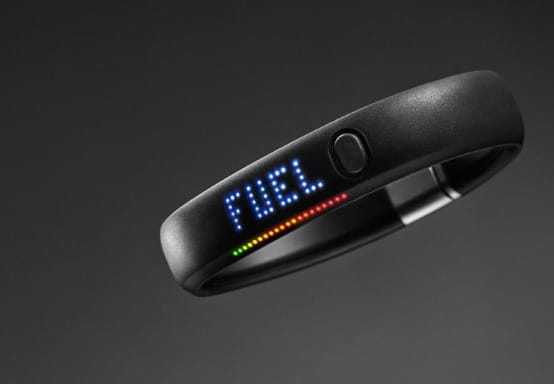Gamified Performance
Technology that uses game mechanics and enables self-tracking is changing how people play sport, keep fit and stay active.

Fun and fitness are good and well, but the core of sport is quantifiable feats of athletic prowess. From Epinician poems praising Ancient Olympic victors to The Guinness Book of Records, simply competing is not enough; objective greatness must be achieved.
That may not be a problem for professional athletes, but what about those of us who will never, say, be in the lane next to Michael Phelps? Amateurs can set goals and feel a sense of accomplishment, but it’s just not the same as feeling the weight of 14 gold medals around your neck. Thankfully, new technology and age-old self-monitoring techniques are coming together to help us intramuralists get more from our sport.
Coined by Wired magazine's Gary Wolf in 2007, Quantified Self is “a collaboration of users and tool makers who share an interest in self knowledge through self-tracking.” Of course self-tracking is not a new pursuit. Men and women of science have been keeping records on diet, sleep, athletic feats and other human activities [see: Alfred Kinsey] for centuries. But the QS movement has swelled in popularity over the last five years, now with active Meetup groups in more than 60 cities around the world. This is due in part to increasingly smarter and smaller technology.
A slew of new gadgets have made self-discovery and self-improvement much easier, and even more fun. Things like time spent working, time spent sleeping and changes in emotional state are now all effortlessly measurable to a high degree of accuracy. While its focus is broader than sport, the QS movement has also made it easier for the weekend warrior to set challenges, track progress and celebrate achievements. So if you really want to live like an Olympian, now all you need is a few relatively inexpensive gadgets…and seriously lowered expectations.
A great example of a QS-inspired device is Hind Hobeika’s Butterfleye (price TBD). Hobeika, who describes herself as a “self-tracking engineer”, developed the Butterfleye so swimmers could visually monitor their heart rate while in the pool.
“The swimmer places Butterfleye on their goggle’s strap. They can set the target heart rate using the buttons. Butterfleye's sensor measures the heart rate from the temporal artery, and depending on the difference between the measured and the target heart rate, a color is reflected indirectly into the lens: green if on target, red if they should slow down and yellow if they should go faster.”
Some tools that fall under the QS umbrella are so simple you can use them in your sleep. Maciek Drejak Lab’s Sleep Cycle app ($0.99), for example, employs your smartphone’s accelerometer to monitor subtle mattress movements. The app then maps your sleep cycle— a process that used to require an overnight lab visit— and wakes you during the lightest stage of sleep.

Things like time spent working, time spent sleeping and changes in emotional state are now all effortlessly measurable to a high degree of accuracy But sleep is for the weak. We’re talking about smash-mouth competition here! QS developers understand the power of play, and are in turn Gamifying many of their applications. Gamification incentivizes users to complete tasks (e.g. jog, meet a sales quota, stay positive) by offering prizes— tangible or otherwise— for accomplishing goals. Gamification also means QS can dovetail with the biggest e-word of the last decade: Social. Yes, self-quantifiers are known for collaboration, but they also compete amongst themselves.
The best-known QS gadget is probably the Nike+ FuelBand, which promises to “[tell] you more about yourself than you ever knew before" by tracking the progress of your daily exercise goal on a digitized bracelet (the band retails for $149, the accompanying app is free). Stats can then be shared through social media, allowing you to work with or against your friends to achieve a goal. Similarly, Fitocracy (free) is an online game and social network dedicated to “[making] fitness a more fun, more addictive experience” by way of friendly competition.
Head-to-head exhibition is enough potential glory for some, but others will need more motivation. How about outrunning a brains-hungry horde of the undead? Six to Start has taken gamification a step further with Zombie’s, Run! The jogging app features an interactive storyline penned by award-winning writer Naomi Alderman. In Six to Start’s own words, Zombie’s, Run! is “an ultra-immersive running game and audio adventure. We deliver the story straight to your headphones through orders and voice recordings— and when you get back home, you use the supplies you’ve collected while running to build and grow your base.” Priced at $7.99, Zombies, Run! has proved popular, with more than 100,000 downloads. “As far as I'm aware, Zombies, Run! is the *only* app that makes the actual act of running more fun,” says Adrian Hon, CEO of Six to Start. “In other words, it doesn't just give you a shiny badge and 50 points after doing a 5k. You become the hero in a fantastically rich and immersive story that makes it vitally important that you keep running.” How many post-apocalyptic landscapes has Michael Phelps traversed?
If Zombies, Run! sounds too intense, Teemo (free) is Gamified Lite. Created by Ammunition Group and Bonnier R&D, the app combines “short and sweet” exercises with travel adventure narratives. It has a similar social element to the Nike+ FuelBand and Fitocracy, and also includes instructional videos for the more than 100 two-minute exercises. “We're aiming for people who need to move more, but who think they don't have time to get to the gym,” says Megan Miller, Bonnier R&D’s Program Director. “Busy professionals, business travelers, busy parents, etcetera. Teemo is designed to be done with just a few square feet of space and no extra equipment.”
If the QS movement continues to grow (it’s showing no signs of slowing down), there’s no doubt we’ll see a greater variety of tools that help athletes of all levels get motivated and track their progress.


